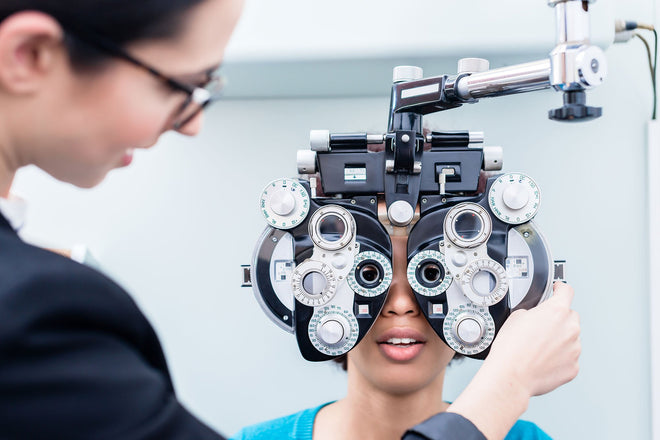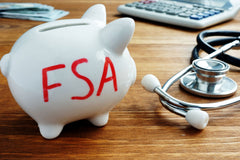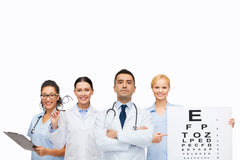A simple eye exam can prevent many problems by detecting them before they do damage. A routine eye exam can detect glaucoma, cataracts, macular degeneration, and other eye diseases. Here’s how it all works.
What Happens in an Eye Exam?
First, your eye doctor will ask you for your medical history and whether or not you have been experiencing any vision-related problems. It would be wise to take your old contacts or glasses with you to your exam if available.
During the eye exam, the eye doctor will determine your distance and reading prescriptions. This is accomplished using an autorefractor, a device that shines a light into the eye and measures how it bounces back.
The device then automatically prints a report of your approximate distance eyeglass prescription. This approximation is then fine-tuned by the eye doctor, who gives you a series of choices to determine the final prescription through a bank of lenses called a phoropter (this is the part where you put your eye up to the big machine, and the eye doctor says, “which is better: 1 or 2?”.
Eye Health Check During Your Exam
The eye doctor checks for your eyes’ health by examining different eye structures and layers – including the lens, cornea, and more – with an instrument called a slit lamp. This specialized microscope allows the doctor to see all of the structures in detail and determine if everything looks normal.
The eye doctor also checks your eye pressure, color vision, visual acuity, eye muscles, and other structures, including the eyelids, iris, and sclera (whites of the eye).
After checking the front of the eye, the doctor then examines the retina or back of the eye. This is where they can see blood vessels, nerves, and tissue by looking through the pupil. The eye doctor can view the retina in an undilated eye by the use of an ophthalmoscope.
The view of the retina is limited since it’s like trying to look at a large room by looking through a door’s keyhole. However, by doing a dilated eye exam, the eye doctor can view a much larger area of the back of the eye.
How Systemic Diseases Are Detected
During a dilated eye exam, the eye doctor can see small plaques and constrictions in the blood vessels that may signal a hardening of arteries and veins, indicating a danger of hypertension or high cholesterol.
The eye doctor can also detect signs of diabetes when looking in the back of the eye. This is often depicted as leakages of blood and fluid in the small blood vessels of the retina. When the eye doctor detects these hallmark changes, these signs indicate uncontrolled diabetes called Diabetic Retinopathy.
When an eye doctor sees these signs, they will order more tests and work with your physician to manage your condition, whether your cardiologist, neurologist, or family doctor.
Those of you over the age of forty should consider an annual eye exam as part of your annual health care regimen. Along with diet, proper exercise, and taking supplements, it is essential to your overall strategy in living a long and healthy life.
Different Types of Eye Exams
There are various types of exams available depending on your needs, common ones include:
- Comprehensive Exam: This exam is the most common and is recommended once per year.
- Routine Exam: Routine exams are shorter and involve the vision, pupil, eye movement, and eye pressure test to look at essential eye health.
- Contact Lens Exam: Before contacts can be prescribed, a contact lens exam is required to determine your depth perception, visual acuity, and eye health.
- Reading Glasses Exam: The reading eyeglass prescription is determined after the distance prescription. A reading card is placed in front of the phoropter at a determined length (such as an arm’s length for computer screens, for example), and different powers are trialed to get to the right power to make the small print on the reading card clear.
- DMV Exam: These usually occur at the DMV and are required to obtain or renew a driver’s license. It’s important to note that an eye doctor does not conduct these types of exams.
- Follow-Up Exam: Follow-up exams are needed if your doctor discovers any problems during your comprehensive exam.
How Often Should I Get an Eye Exam?
It is recommended that you receive a comprehensive eye exam once a year to identify any vision problems early on or see if your prescription needs updating.
However, your specific exam frequency may vary depending on your age, family history, and health. It’s important to talk to your eye doctor to determine how often you should be receiving an exam.
How Long do Eye Exams Take?
Comprehensive eye exams typically last an hour. Your doctor will run a series of tests to get your prescription and look for any signs of glaucoma, cataracts, macular degeneration, and other eye diseases. Depending on your doctor’s testing methods, your exam could be shorter or much longer.
Cost of Eye Exams
The average price of a comprehensive eye exam is $100. That said, the price can vary dramatically based on various factors such as insurance, location, and your specific needs.
Eye exams are free with insurance and up to $200+ without insurance. Ensure you receive a quote from your eye optometrist before you go in for your eye exam for exact pricing.
Dilated Eye Exams
With the use of dilating drops, the eye doctor can temporarily dilate your pupil to give a bigger window to the retina and detect any retinal diseases and evidence of systemic diseases such as high cholesterol, high blood pressure, and diabetes. This is often before your cardiologist, neurologist, or general physician can detect these changes to your health.
Plus, when the eye doctor looks at the retina, their training allows them to note very small changes in the appearance of blood vessels that can reflect damage not only to the retina but to the brain, heart, lungs, and more.
Refraction Eye Exams
Refraction eye exams assist your doctor in getting your prescription just right. For this test, your doctor will use a phoropter to give you a series of choices to determine your final prescription. A phoropter uses a bank of lenses for you to look through to see which one corrects your vision the best.
Visual Acuity Tests
A visual acuity test examines each eye to see how well it individually sees. Your doctor will ask you to cover one eye and read off a chart with various-sized letters and numbers from a distance. This helps your eye doctor determine how well you can see from a specified range.
How to Improve Vision
There are many things you can do to help preserve your vision and slow down age-related eye problems, including:
- Vitamins: Vitamins A, C, and E are perfect for the health of the retina (back of the eye) as well as helping to slow down the progression of cataracts and macular degeneration.
- Eat Foods for Eye Health: You can get vitamins A, C, and E from many food sources. Vitamin A can be found in carrots, which are also rich in beta carotene. Vitamin C can be found in leafy greens such as kale, or citrus fruits such as oranges. Lastly, nuts and seeds are a good source of vitamin E.
- Aerobic Exercise: When you move your body, it increases the circulation of the blood in your heart, lungs, and especially your retina.
- Rest Your Eyes: When working on digital devices, consider doing the 20-20-20 rule for your eyes, which means looking away from your computer screen for more than 20 feet, every 20 minutes, for 20 seconds.
The Bottom Line
Regular eye exams are one of the best ways to ensure your vision is at its best. Most people think of an eye exam as just adjusting your eyeglass or contact lens prescription so that you see better; however, it also does a battery of tests designed to detect eye diseases such as cataracts, glaucoma, diabetes, and macular degeneration. Find more ways to safeguard your eyes here.
Looking for Reading Glasses?
Shop Now





